How to construct a cesspool of concrete rings: schemes + step-by-step guide
Do you choose the simplest way to collect and partially process sewage for your summer house or seasonal residence? Agree that the arrangement of the sewage system will significantly refine the site and make your stay in the country as comfortable as possible. An ordinary cesspool of concrete rings will cope with this task, but you do not know how to build it correctly?
We will help you deal with this type of septic tank - the article discusses the construction of the pit, popular building schemes. The process of designing a cage from the rings with the calculation of the required volume is analyzed in detail, its phased construction is described.
The material is equipped with visual photographs and diagrams, video recommendations for construction from experienced craftsmen are given. Also discussed are methods of decorating a technical hole.
The content of the article:
Design and purpose of the cesspool
Cesspools, like septic tanks, are used to collect sewage. But these are primitive structures that are not able to purify the liquid.
In storage tanks, waste only partially decays, in contrast to VOCs, where the waste is divided into solid waste and liquid, which is subsequently clarified and reaches a purity of 60-98%.
All varieties drain pits can be divided into two categories:
- sealed storage tanks;
- drain holes with a filter bottom.
For users, 2 differences are important - the bottom of the tank and the frequency of waste collection. The first type stores the entire volume of sewage, so it is emptied quite often, once every 1-2 weeks.
For the second type, sewer pits are less likely to be called, since the tank is filling a little slower. Part of the liquid seeps through a kind of filter that replaces the bottom, and enters the soil.
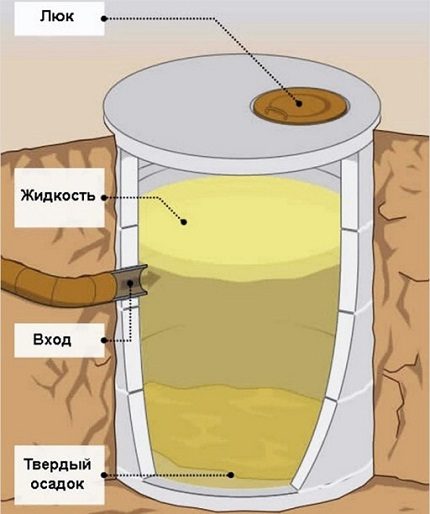
At first glance, the second option is more acceptable, but it can only be used for processing gray effluents.
At pit device without bottom A number of factors must be considered:
- sanitary requirements;
- soil type;
- the presence and location of aquifers.
If the soil in the selected area is clayey, not able to quickly absorb water, there is no point in making a filter bottom. The same with aquifers - there is a risk of infection and environmental damage.
There are many solutions to cesspools: build brick structuresconcrete or car tires. The most reliable are concrete structures and finished plastic containers.
Reservoirs made of concrete, created by the construction of formwork and pouring, are more difficult to build than the analogues of the finished rings, which we dwell on.
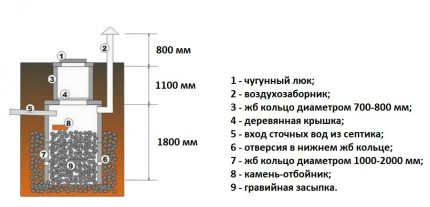
The rake from the concrete blanks of a cylindrical shape in finished form is a well from 2 m to 4 m in depth. Rings in the amount of 2-4 pieces are placed one on top of the other, seals are sealed.
The bottom element, depending on the type of pit, may be closed or completely absent. Sometimes, instead of a finished factory blank, a concrete slab is put to the bottom.
The upper part is designed in the form of a neck with a technical hatch and a tight-fitting lid.
The main accumulative part of the tank is deepened by about 1 m, since the inlet sewer pipe should be below the level of freezing of the soil. The capacity volume is selected, taking into account the number of daily drains.
Why are drain pits attractive?
The main advantage of drives is affordable cost. For this reason, many stop at the simplest device instead of acquiring a more expensive and functional septic tank.
The rake is also convenient for those who rarely come to the cottage - only in the warm season or exclusively on weekends.
If there is relatively little sewage and regular waste pumping is established, a cesspool is really a good option.
But with large volumes of wastewater is better pick up a septic tank - a more expensive device that partially cleans waste and minimizes pollution of garden land.
The latter is possible if a model with filter well or infiltrator.
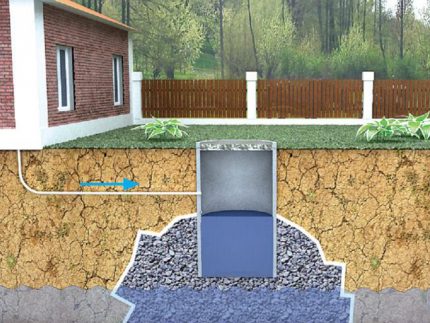
Disadvantages of the cesspool, which may become a causal refusal from its construction:
- limited volume;
- the need for frequent pumping;
- low (or zero) degree of waste treatment;
- a specific smell that is difficult to get rid of.
Those who want to install a filtering sewage system should know that from time to time, along with pumping, it will be necessary to clean and even replace the filter - a gravel or gravel layer at the bottom of the pit.
Overview of popular building schemes
Even the construction of two main types of cesspools can have nuances. Consider the features of the most popular schemes of concrete rings.
The first scheme is a sealed hermetic well of two standard rings and one narrower neck ring.
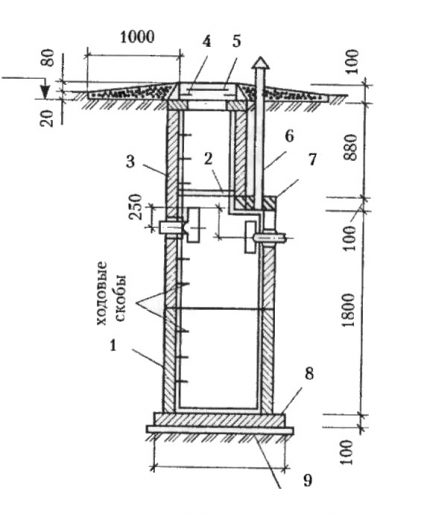
The following diagram clearly shows the difference between the storage tank and the tank with a filter bottom.
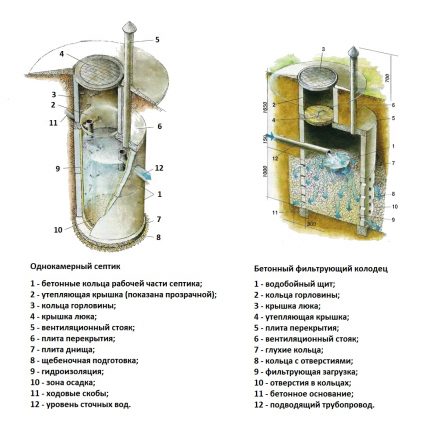
The third option is a modernized drive, a primitive septic tank.
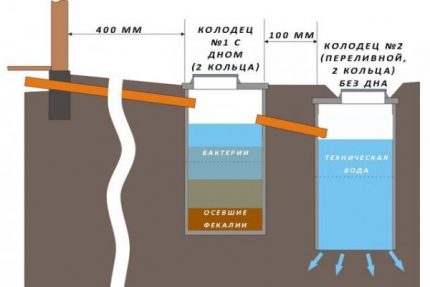
Using a two-section overflow drive more appropriate, as it increases the degree of environmental friendliness. Sometimes models from three compartments are used - the more there are, the more efficient is the treatment of effluents.
A brief photo-manual on the construction of the pit
The construction of a cesspool using concrete rings involves a number of traditional steps.
So that readers can visualize the process, we suggest that you familiarize yourself with the photo-report of the builders:
Designing and calculating
Starting construction without preparation, you risk violating sanitary standards and creating a device with limited functions. In order for the cesspool to work 100%, it is necessary to provide for all the nuances and difficulties of construction.
Step # 1 - locating the drain pit
When choosing a place for a cesspool, it is important to consider two points: ease of maintenance and compliance with sanitary standards.
Accordingly, to facilitate the installation process and better functionality of the entire sewer system, the tank must be installed as close as possible to the house.
Many do just that - they dig a container 2-3 meters from the building, not paying attention to the smell and forgetting about the norms and rules for using drain pits and various septic tanks. By the way, the recommended minimum distance from the pit to the house is 5 m.
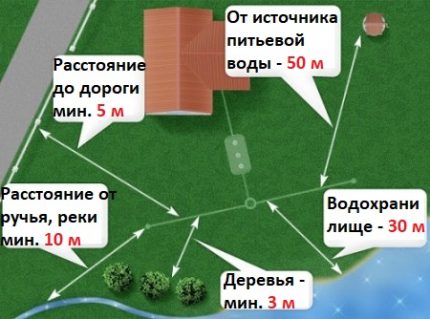
The scheme can be supplemented with the following information:
- sealed container set in any type of soil;
- filter tank - only in sandy, well absorbing and passing liquid.
The base of the filtering structure should be at least 1 m higher than the aquifer.
To determine the depth of the aquifers, it is better to contact the design or drilling organization that carried out geotechnical surveys or drilling a water well in the construction area.
Step # 2 - calculation of capacity
To determine the size and volume of the well, it is necessary to make simple mathematical calculations. If the permanent home has a shower, toilet, washing machine, then for 1 person there are approximately 150-200 liters of sewage daily.
Suppose you want to install a sealed cellar in the courtyard of a house where 3 people live - it turns out 450-600 liters per day.
Do not forget that in the calculation we take into account at least a 3-fold amount, that is, once again we multiply by 3, we get 1.35-1.8 m³. This is the minimum volume.
The dimensions of the neck and parts of the well located above the entrance of the sewer pipe do not need to be taken into account. That is, the volume obtained is the parameters of the part located below the pipeline.
Sometimes repelled by the timing of the call of the cesspool workers. If the same family of 3 people is served every week, then it turns out: 150 l (200 l) x 3 x 7 = 3.15 m³ (4.2 m³). Once every two weeks - 6.3 m³ (8.4 m³).

If the public utilities or the private company serving your site has transport with a tank of 6-8 m³ in the park, it makes sense to install the maximum volume tank.
Step # 3 - Selecting Concrete Rings
The volume of the cesspool is calculated by the size of the rings, so it is easier to purchase models from the assortment of a company located nearby, since delivery is required.
Typical ring sizes:
- height - 0.89 m;
- diameter - 1m.
Rings with such dimensions are produced by almost all concrete products plants. For a small family, three blanks are enough, plus a neck and a bottom.
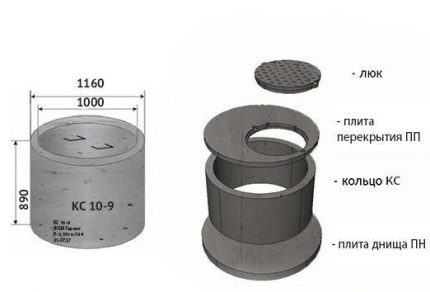
The construction of cesspools is so popular that factories began to produce complete kits for their construction.
The kit includes:
- bottom element with bottom;
- standard rings from 1 to 5 pcs. - a larger number will cause difficulties with cleaning and pumping;
- narrowed neck;
- upper slab with a hole for the hatch.
Rings can be plain and perforated for absorbing wells. Sunroof with cover purchased separately.
In addition to standard concrete rings meter diameter you can find more overall workpiece.
Preference should be given to rings with a locking groove-to-comb connection, which guarantees a higher degree of tightness and strength of the finished structure.
Step # 4 - preparing materials and renting equipment
In addition to a set of concrete blanks, the following building materials may be required:
- staples for connecting parts;
- joint sealant;
- bituminous mastic or other material for sealing the tank from the inside and outside;
- cement to strengthen the backfill;
- crushed stone, gravel and sand for the preparation of leveling screed or filter layer.
Do not forget about buckets, shovels and winches for excavation.
It is not possible to independently deliver concrete rings - for large and heavy parts it is necessary to rent a truck.
If a winch is not provided at the construction site, it is better to order special equipment with a manipulator. One person cannot handle it. The only thing you can do yourself is to dig a pit.
For the installation of workpieces, at least 2-3 pairs of working hands plus a truck driver are required.
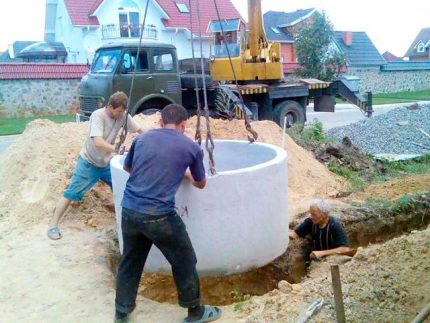
The ideal option is the help of friends with whom you can agree on a low payment. If there are no special equipment drivers and installers among friends, you can rent a car and pay for the services of a team of workers.
Often the help of professional installers is offered by a company selling rings for wells and drain pits.
Cesspool construction instructions
The installation of each particular tank has its own nuances associated with the features of the landscape, soil, the location of the sewer network, etc. We will consider a typical scheme of a cesspool device.
Stage # 1 - excavation
The first stage is land work. They can be performed alone (long, hard and free) or with the help of a team (fast and fun, but for money).
If possible, you can attract a mini-excavator, then working hands will be required only for "grinding" the walls and leveling the bottom of the pit.
The shape and dimensions of the pit should correspond to the configuration and dimensions of the tank. Accordingly, a round well should be obtained, with a width exceeding concrete rings by 0.3-0.5 m on each side around the circumference.
This gap will be required to seal / warm the structure from the outside and then fill it with a seal.
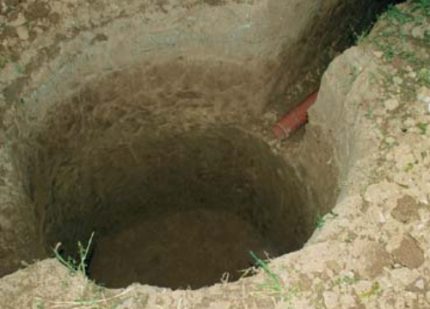
There is one caveat that should not be forgotten - this is the level of soil freezing (information is relevant for residents of the middle zone and the north of Russia).
The sewer pipe for drains and the main part of the tank must be below this level in order for the system to function in winter. If you lay the net near the surface, the liquid will simply freeze when frost sets in.
In this regard, the height of the neck, which serves, in fact, as a technical hole, must be added to the dimensions of the working capacity. The neck should protrude 15-20 cm above the ground.
Thus, the tank will be buried, as well as a sewer pipe cut into it below the freezing level.
By the beginning of construction work, it is necessary to level the base with the walls and dig a ditch leading from the house (bath, summer kitchen, garage) to the sewage pit.
When installing the ditch, do not forget that in order to avoid blockages, the pipe should have a slope towards the pit - about 2 cm per meter.
Stage # 2 - arrangement of the bottom
If you install an ordinary storage tank, the bottom, like the walls, should be airtight. For the construction of concrete rings, the best option is to prepare from the same material.
The part is specially designed to design the bottom of the well and has a groove around the circumference. The only thing necessary for its installation is an even, dense base.
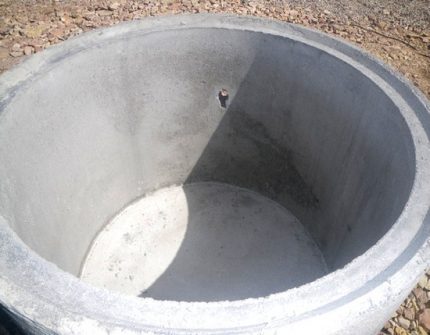
Possible subsidence of the base is eliminated by pouring a cement screed. They prepare it according to a simple scheme: for each part of cement - 4 parts of sand. For strength, crushed gravel can be added in a ratio of 1: 6.
The mass is prepared in a container, then it is poured over the entire area of the bottom of the pit and leveled. Within a week, the concrete screed is slightly irrigated with water so that it does not become cracked. The lower element of the structure is installed no earlier than a week later.
For those who value time, there is a more practical solution - a ready-made concrete slab of factory manufacture. It is laid on a flat bottom, and the first concrete ring is already placed on it.
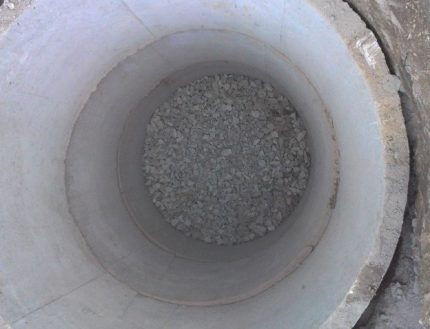
Colonies of anaerobes, bacteria involved in the decomposition and treatment of waste, settle on the backfill from rubble or gravel.
The thickness of the underlying backfill is different:
- shallow pits - from 0.3 m;
- tanks of 3-4 rings - up to 0.6-0.7 m.
The power of the filter backfill placed in the wellbore should be at least 1.0 m.
The layout of the layers is as follows:
- bottom layer - sand;
- middle layer - crushed stone of small fraction;
- upper layer - crushed stone of a large fraction.
Unlike the concrete tank, the “pillow” and filter are interchangeable elements. When they become clogged with solid waste and stop passing liquid, they remove the old filling and put a new one on the bottom of the pit.
Stage # 3 - installation of concrete rings
The first ring equipped with a bottom is installed directly on a concrete slab (or screed). Smooth installation of the part is a guarantee of a strictly vertical position of the entire structure, without tilt and distortions. A second element is placed on the bottom element and the seam is immediately sealed.
For grouting and waterproofing of joints, various solutions, coating and roll materials are used. Using roofing material glued to the bitumen solution, joints and cracks are closed from the outside, it is not suitable for internal work.
Ordinary cement mortar is also considered weak: when the soil moves, its fragility appears, as a result of which it cracks and crumbles.
There are many modern modified mastics and solutions that have sufficient strength and elasticity. Some of them can be applied to wet joints or seams that are already under water pressure.
Involved various capable waterproofing concrete septic tank to protect the walls from the damaging effects of an aggressive chemical environment, which is often found in sewage.
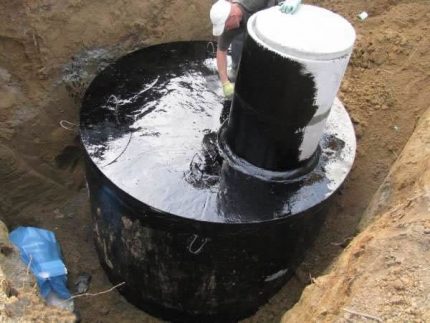
Here are some of the effective tools for joint sealing and internal sealing:
- Water sealswhich expand upon hardening, tightly closing any cracks. Examples: Waterplag, Peneplag, Hydrostop. Their only negative is the high cost.
- Solutions for application to the entire surface: Antihydron, Hydrotex, Bastion.
- Caulking materials deep seamsimpregnated with Kiilto FIBERPOOL fibroresin - cords and ropes from jute, flax, hemp.
- Rubber sealing stripse.g. RubberElast.
- Liquid glassadded to cement mortar
- Water based sealants: Peneplag, Penetron, Penekrit.
High-quality waterproofing ensures structural integrity for up to 35 years.
After making sure that the connection between the rings does not allow water to pass through, you can install the following part.
Approximately 20 - 30 cm below the depth of seasonal freezing of soils, it is necessary to make an inlet for the sewer line. At the same stage, a pipe is laid and connected to the tank. The junction is carefully sealed.
In the northern regions, pipes passing above the freezing depth are additionally insulated, as is the upper part of the storage tank.
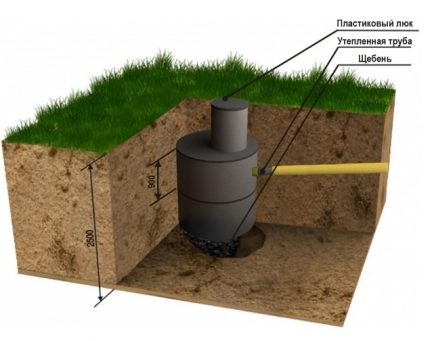
A throat is mounted on a 3 or 4 ring, then a floor slab. The factory-made stove has a round hole for the hatch. Another hole, smaller in diameter, is required for the ventilation pipe.
The final touch is backfill. If dry cement is added to the soil, the reliability of the structure will increase, and the risk of destruction by soil movements will decrease.
Stage # 4 - technical hole design
The best option for outdoor decoration is sewer manhole with a tight-fitting lid. Its inexpensive counterpart is simply a wooden lid hinged.
The hatch is necessary for servicing the cesspool - pumping waste or replacing the filter layer.
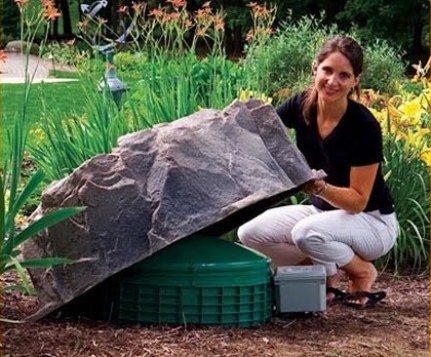
Recently, it is customary to mask sewer structures, especially if they do not look aesthetically pleasing enough. For this purpose, they acquire decorative products imitating green spaces or large stones.
But it is not necessary to use purchased decor, you can collect an elegant flower stand from wooden battens and decorate it with flowering plants.
Conclusions and useful video on the topic
A few tips from professionals will help you determine the type of pit and build a tank of concrete rings in accordance with all the rules.
Stages of the construction of a cesspool with detailed comments:
Installation of concrete rings:
Useful information about hatches:
As you can see, the construction of a cesspool from concrete billets is available even to an inexperienced builder. But remember that for the construction of a functional structure, compliance with standards, a verified design, accurate calculations and, most likely, the assistance of installers.
If you are unsure of your abilities, consider installing. storage tank made of plastic or even a factory septic tank.
Do you have personal experience in constructing a cesspool of reinforced concrete rings? Want to share useful information or ask questions about the topic? Please leave comments - the feedback form is located below.

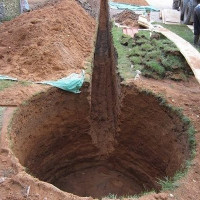 How a cesspool is constructed without a bottom: schemes and arrangement rules
How a cesspool is constructed without a bottom: schemes and arrangement rules 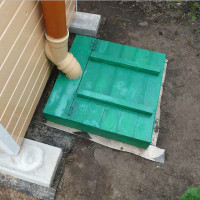 How a cesspool is constructed in a private house: a review of structures + rules for their arrangement
How a cesspool is constructed in a private house: a review of structures + rules for their arrangement 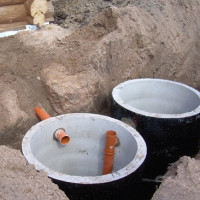 How a cesspool with overflow is arranged: schemes and construction technology
How a cesspool with overflow is arranged: schemes and construction technology 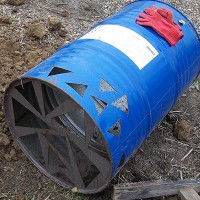 Barrel pit: step-by-step master-class on arrangement
Barrel pit: step-by-step master-class on arrangement 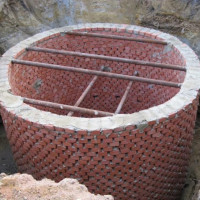 Do-it-yourself cesspool: analysis of popular options for arranging
Do-it-yourself cesspool: analysis of popular options for arranging 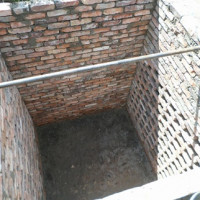 How to build a drain pit of brick: options and methods of arrangement
How to build a drain pit of brick: options and methods of arrangement 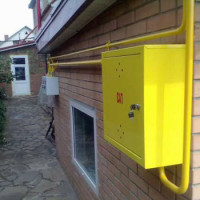 How much does it cost to connect gas to a private house: the price of organizing gas supply
How much does it cost to connect gas to a private house: the price of organizing gas supply  The best washing machines with dryer: model rating and customer tips
The best washing machines with dryer: model rating and customer tips  What is the color temperature of light and the nuances of choosing the temperature of the lamps to suit your needs
What is the color temperature of light and the nuances of choosing the temperature of the lamps to suit your needs 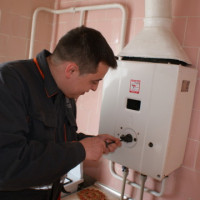 Replacement of a geyser in an apartment: replacement paperwork + basic norms and requirements
Replacement of a geyser in an apartment: replacement paperwork + basic norms and requirements
Interesting stuff. You do not often come across such high-quality instructions with videos, diagrams and illustrations. Immediately a question for the author: installation of concrete rings suitable for any type of soil? And I would like to add on my own that you can specify the approximate cost of renting equipment and materials. And it’s good if there was information on the wear of concrete rings, on their strength and on the impact of external factors on them. It was helpful)
Good day, Sergey. Yes, a cesspool of concrete rings can be built in all types of soils. Only with high groundwater should attention be given to waterproofing.
It’s incorrect to indicate approximate costs. Due to the difference in prices depending on the region at times, which sometimes can be three or even five times.
Due to the strength and moisture resistance of concrete products, the service life is, without exaggeration, about a hundred years.
I have this situation. He began on his own to make a cesspool of concrete rings in the country. But I had to leave and my well was unfinished for 2 years. The trouble is that I managed to dig in two rings and two remained. So around the dug rings, the soil was already compressed and compacted by itself. Now they can not be dug deeper, and they cannot be pulled back. Can you come up with something, how can I finish building a well?
Buy two more rings of smaller diameter and dig them inside these two rings.
Hello. Take a look, please https://engineeris.decorexpro.com/en/vodosnab/kolod-skvazh/uglublenie-kolodcev.html, section - “Deepening with rings of smaller diameter”. Here about water supply, but there is not much difference in technology.